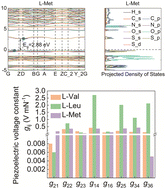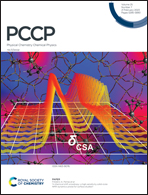Identification of biomolecule-based electronic materials from a first-principles study of aliphatic amino acids†
Abstract
Biomolecule-based electronic materials can enable health innovations by virtue of their intrinsic bioactivity and physical properties. However, the ultra-wide bandgap and limited piezoelectric properties of most biomaterials prevent them from reaching their full potential. Herein, the electronic structures and electromechanical properties of aliphatic amino acid crystals are investigated based on density functional theory. L-Met is found to be a wide bandgap p-type semiconductor, and the much-reduced bandgap of 2.88 eV is ascribed to the sulphur atoms in L-Met. L-Leu has a shear piezoelectric voltage constant of 2.706 V mN−1 that is over an order of magnitude higher than that of lead zirconate titanate, and good toughness and ductility are also revealed in L-Leu from mechanical property investigations. This study illustrates a computational approach to find smart and multifunctional biomaterials and inspire their growth and applications.



 Please wait while we load your content...
Please wait while we load your content...